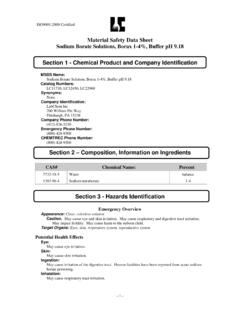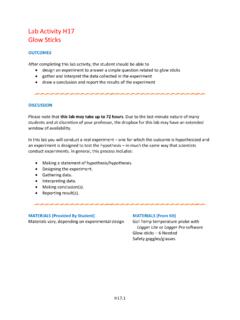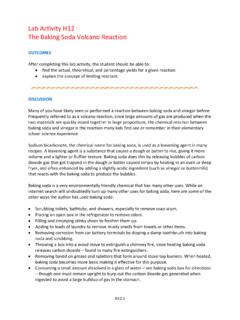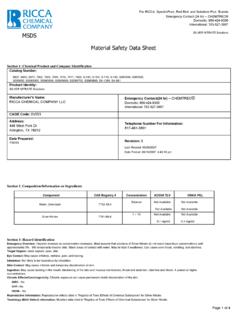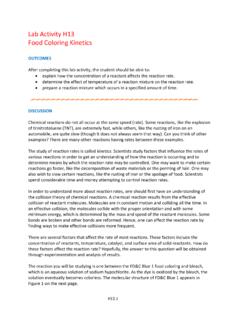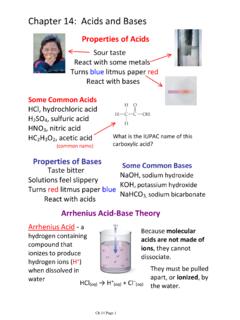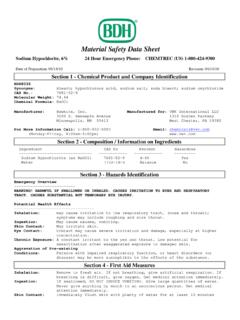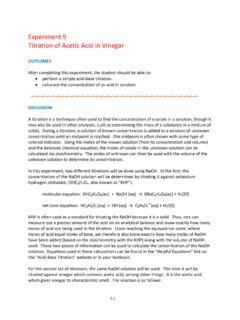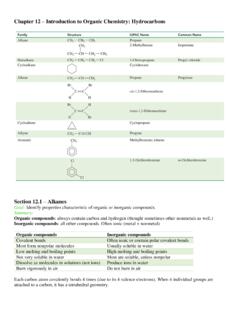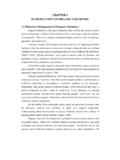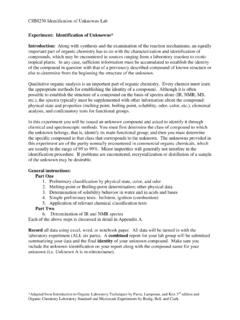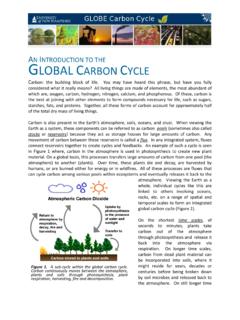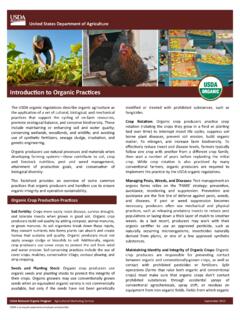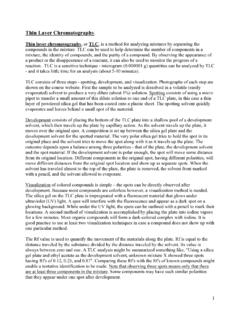Transcription of Experiment 3 An Introduction to Functional Groups in ...
1 Experiment 3 An Introduction to Functional Groups in organic Molecules* OUTCOMES After completing this Experiment , the student should be able to: perform Functional group identification tests. identify an unknown organic molecule based on its Functional group. write an abstract for a lab report. DISCUSSION Qualitative organic analysis, the identification of organic compounds based on their physical and chemical properties, is analogous in some ways to the identification of plants and animals according to their taxonomy--their structural features and presumed natural relationships. To classify an organic compound into a given family requires first detecting a specific Functional group (characteristic set of atoms) in the molecules of organic compounds. Functional Group Name General Formula* Functional Group Name General Formula* Alkene R-C=C-R' Amine R'RR'R"RR Alkyl halide R-Cl or R-Br Carboxylic acid R(R-COOH) Alcohol R-O-H Ester RR' Aldehyde R(R-CHO) Ether R-O-R' Amide RR' Ketone RR' *R, R', and R" are general hydrocarbon chains Table 1.
2 Some common organic Functional Groups . Because Functional Groups influence the physical, chemical, and spectral properties of an organic compound, a chemist can identify a compound's Functional Groups by measuring certain physical properties, observing its chemical behavior with different classification reagents, and studying other spectral data. Chemists have developed a number of simple chemical tests that are positive only for compounds having certain kinds of Functional Groups . In this Experiment , we will be using four of these tests to identify an unknown organic compound. The tests being utilized include the following: Chromic acid test. Reacts quickly with primary and secondary alcohols; slowly with aldehydes. 2,4-Dinitrophenylhydrazine (2,4-DNPH) test. Reacts with aldehydes and ketones. Potassium permanganate test. Reacts with alkenes. Beilstein's flame test. Reacts with alkyl halides.
3 PROCEDURE Wear safety glasses or goggles at all times for this Experiment . Avoid skin contact with the chemicals in this Experiment . Wear gloves when performing the procedures and change gloves if you spill on them. NOTE: Some tests may provide ambiguous results. The purity of the test reagents and the unknown compound can have adverse effects on these tests, so it is especially important to prevent cross-contamination. 1. Obtain a numbered unknown from your instructor and record its number in your laboratory notebook. Important: cap your unknown vial tightly after removing the required amount for the tests, as these compounds may have strong smells and will evaporate very quickly! 2. Perform the four procedures in any order. The tests will be set up in fume hoods in the lab. You will be doing three trials for each procedure: one positive test, one negative test, and your unknown compound.
4 Procedure 1: Chromic acid test (alcohols) 1. Dissolve one drop of ethanol in 500 L of reagent-grade acetone in a small test tube. 2. Add 1 drop of the chromic acid reagent, stopper the tube with a small rubber septum and shake the mixture. Observe it for at least one minute, noting the time required for any positive test. Carefully record your observations. The septa are expensive and are not disposable, so please rinse them and return them to your instructor when finished. 3. Repeat steps 1 and 2, using one of the other known organic compounds (limonene or bromobenzene) in place of the ethanol. 4. Repeat steps 1 and 2, using your unknown solution in place of the ethanol. Place small test tubes in waste container in the hood. Rinse and return septum. Procedure 2: 2,4-Dinitrophenylhydrazine (2,4-DNPH) test (ketones) 1. Add one drop of reagent-grade acetone to 500 L of the DNPH reagent in a small test tube.
5 2. Stopper the tube with a small rubber septum, shake the test tube and let the mixture stand for 15 minutes. Carefully record your observations. The septa are expensive and are not disposable, so please rinse them and return them to your instructor when finished. 3. Repeat steps 1 and 2, using one of the other known organic compounds (limonene, ethanol or bromobenzene) in place of the acetone. 4. Repeat steps 1 and 2, using your unknown solution in place of the acetone. Place small test tubes in waste container in the hood. Rinse and return septum. Procedure 3: Potassium permanganate test (alkenes) 1. Dissolve one drop of limonene in 500 L of 95% ethanol in a small test tube. 2. Slowly add 5 - 10 drops of M potassium permanganate with shaking. Note what happens after each drop is added and carefully record your observations. 3. Repeat steps 1 and 2, using one of the other known organic compounds (acetone or bromobenzene) in place of the limonene.
6 4. Repeat steps 1 and 2, using your unknown solution in place of the limonene. Place small test tubes in waste container in the hood. Rinse and return septum. Procedure 4: Beilstein's flame test (alkyl halides) 1. Make a small loop in the end of a 10-cm length of copper wire. Heat the loop to redness in a burner flame. Keep the unknown and any other flammable liquids at a safe distance. 2. Dip the loop into a little bit of bromobenzene and hold it in the lower outside part of the flame. Note the color of the flame produced. Carefully record your observations. 3. Repeat step 2, using one of the other known organic compounds (limonene, ethanol or acetone) in place of the bromobenzene. 4. Repeat steps 1 and 2, using your unknown solution in place of the bromobenzene. Place the copper wire in the proper container in the hood. When all of the tests have been performed and you are sure of the identity of your unknown, dispose of any unused unknown chemical in the waste container and place the empty vial in the collection bin provided.
7 DATA ANALYSIS 1. Using the organic modeling kits, make models of each of the four standard chemicals used in the positive and negative tests (ethanol, acetone, limonene, and bromobenzene). A web search will help you identify the structures of acetone and limonene. Show these models to your instructor. 2. Using ChemSketch, draw the correct chemical structures as line-angle formulas for each of the four standard chemicals used in the positive and negative tests. 3. Make an organized table that neatly shows the results of your four positive and negative standard tests. The table should include the name of the test, the name of the Functional group being tested for, the names of the compounds being tested, and a brief summation of the observations recorded. 4. Make an organized table that neatly shows the results of the Functional group tests on your unknown compound. The table should include the name of the test, observations, and conclusion as to whether or not the Functional group was present based on the test.
8 5. There were four possible unknowns in this Experiment : 1-bromobutane, 2-butanone, cyclohexene, and 1-butanol. Using the organic modeling kits, make models of each of the four possible unknowns. Show these models to your instructor. 6. Using ChemSketch, draw the correct chemical structures as line-angle formulas for each of the four possible unknowns. 7. What was the Functional group present in your unknown? What was the identity of your unknown? Explain. 8. What were some possible sources of error in this Experiment ? Explain. POSTLAB ACTIVITY You will be turning in a lab report. It may be an individual or group report, depending on instructor preference. The report should include the title, an abstract, results, discussion, and references. The information that you obtained from the data analysis should be included at some point in the report. It is up to you whether it is in the results or discussion or both.
9 However, remember that the report is more than just answering some questions and that it should flow smoothly and logically as you discuss the data obtained, what it signifies, and potential errors or difficulties. Lab report guidelines for how to write the abstract, results, and discussion are found at Follow your instructor s directions for submitting the report. If you are submitting electronically, please submit a single file with all of the required information. Use the following convention for naming your files: Lastname1 Lastname2 Functional Groups for a group report or Lastname Firstname Functional Groups for an individual report. If you are emailing the report, use a subject line of Chem 1062: Functional Groups Lab. *Portions of this Experiment were adapted from Lehman, , Operational organic Chemistry, Upper Saddle River, New Jersey: Prentice-Hall, 1999.
